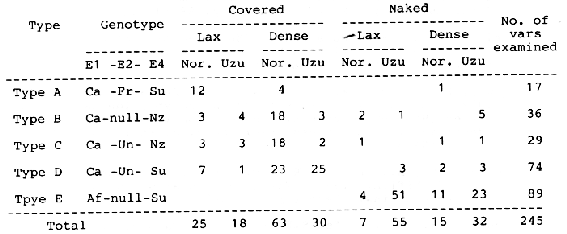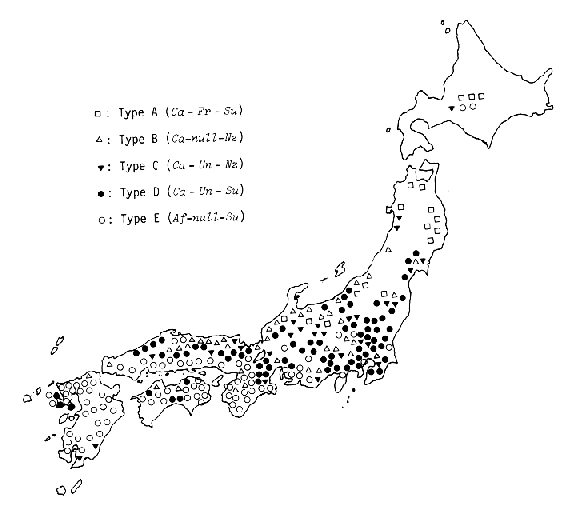

Since early 1970, genetic variation of isozymes in barley varieties have been studied intensively by Prof. R. W. Allard's school in U.S.A., and Dr. G. Nielsen and his co-workers in Denmark. The present authors aimed to obtain the more detailed information about geographical distribution of isozyme genotypes in the world, using barley varieties preserved in Barley Germplasm Center of our Institute. As the first step, genetic variation at three loci of esterase isozymes, Est-1, Est-2 and Est-4, in Japanese barley varieties was investigated.
The materials consisted of 245 six-rowed leading varieties cultivated in Japan before 1940 when barley was one of the main winter crops after rice. The seedlings were grown under the conditions of 18 °C with 12 hr illumination, and the first leaf of a 7-day-old seedling per variety was used for horizontal starch gel electrophoresis using a tris-citric acid System described by Hvid and Nielsen (1977).


According to Khaller and Allard (1970, 1981), there are at least 7, 12 and 7 alleles at the three loci, Est-1, Est-2 and Est-4 respectively, which are tightly linked on chromosome 3. The present experiment indicated that Japanese varieties differentiated 2 alleles (Ca and Af) at Est-1 locus, 3 (Fr, Un and null) at Est-2, and 2 (Su and Nz) at Est-4, and as shown in Table 1, they were classified into 5 different genotypes named A-E, consisting of the combination of these alleles.
Type A (Ca-Fr-Su) varieties were mostly covered, lax-eared and non-uzu (normal or non-semibrachytic) form. They were thought to be introduced from the Occidental regions, because they had genes of bt for non-brittle rachis, JMl-nz for mildew resistance, and s for short-haired rachilla which were frequently found in the barley varieties of Occidental type.
In contrast, most of the varieties of Types B-E were of Oriental type on the other. Varieties of both types, B (Ca-null-Nz) and C (Ca-Un-Nz), were mainly dense-eared, covered barleys of non-uzu type, and those of Type D (Ca-Un-Su) were principally covered, dense-eared varieties of either non-uzu of uzu form. Type E (Af-null-Su) varieties were wholly naked barleys.
Furthermore, these varieties with the five isozyme genotypes were found to occupy different regions of Japan (Figure 1). The varieties of Type A and E were grown in North and West Japan, respectively. Type B varieties were distributed mainly in the northern regions faced to the Sea of Japan, and the varieties of both Types, C and D, were concentrated in Kanto region, eastern part of Japan.
The Japanese barley varieties were classified into several groups with three or four different genic combinations (Takahashi 1942). Arid, the present result furnished a knowledge about further detailed classification, and seemed to offer a useful information about the genetic differentiation of Japanese barley varieties.